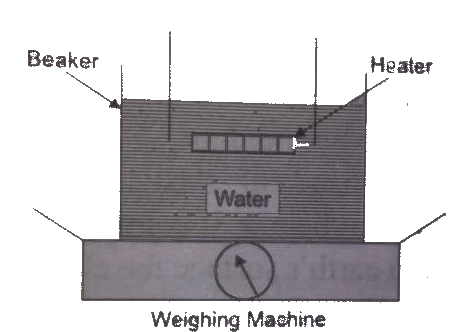In an experiment to determine the boiling point of water state the reason for the following recautions:
(i) The bulb of the thermometer should not touch the sides of the beaker.
(ii) while boiling water pumice stone should be added.
(i) The sides of the glass beaker are at higher temperature than the contents of the beaker .Therfore , the reading geiven by the thermometer touching the sides of the beaker does not give correct resutl
(ii) Pieces of pumice stone are added to boiling water in order to check any bumping .
Topper's Solved these Questions
- STRUCTURE OF ATOM BOOK - DINESH PUBLICATIONCHAPTER - STRUCTURE OF ATOM EXERCISE - Short Answer Questions
7 Videos
- STRUCTURE OF ATOM BOOK - DINESH PUBLICATIONCHAPTER - STRUCTURE OF ATOM EXERCISE - Long Answer Questions
6 Videos
- STRUCTURE OF ATOM BOOK - DINESH PUBLICATIONCHAPTER - STRUCTURE OF ATOM EXERCISE - Multiple choice question
26 Videos
- MATTER IN OUR SURROUNDINGS BOOK - DINESH PUBLICATIONCHAPTER - MATTER IN OUR SURROUNDINGS EXERCISE - (LAQs) Long Answer Questions
5 Videos
Similar Questions
Knowledge Check
During the determination of the boiling point of water the thermometer is kept
Adipped in waterBa little above waterCfar above waterDout of contact with the water vapourDuring the determination of the boiling point of water the thermometer is kept
Adipped in the waterBa little above the waterCfor above the waterDout of contact with the water vapourAs part of an experiment to determine the latent heat of vaporisation of water, a student boils some water in a beaker using an electric heater as shown below. The student notes two sources of error.

Error-1: thermal energy is lost from the sides of the beaker
Error -2: As the water is boling water splashes out of the beaker
Which of the following gives the correct effect of these two errors on the calculated value for the specific lalent heat?AError-1 = increases , Error-2 = DecreaseBError-1 = increases , Error-2 = increaseCError-1 = Decreases , Error-2 = increaseDError-1 = Decreases , Error-2 = Decrease
Why is a delivery tube attached to the flask while determining the boiling points of water ?
View SolutionMohan was asked by his teacher to determine the boiling point of a liquid. He set up the appartus as shown in the figure. He rocorded the boiling point of the liquid as 140∘C and reported the reading to this teacher. The teacher asked him to repeat the experiment after dipping the bulb of the thermometer in the liquid and also placing the beaker on a tripod stand covered with a wire gauze. After reading this narration, answer the following question :
(i) Was the reading taken by the student correct ?
(ii) What was the necessity of wire gauze?
(iii) How did teacher help the student?
(iv) What is teh value based information associated with this?

View SolutionBoojho has three thermometers as shown in figure. He wants to measure the temperature of his body and that of boiling water. Which thermometer (s) should he choose?

View SolutionThe solution which boil at constant temperature like a pure liquid and possess same composition in liquid as well as vapour state are called azeotropes. The components of azetropes cannot be separated by fractional distillation. Only non-ideal solutions form azeotropes. Solutions with negative deviation form maximum boiling azeotrope and the solutions with positive deviation form minimum boiling azeotrope. The boiling point of an azeotrope is never equal to the boiling points of any of the components of the azeotrope.
Answer the following question:
The azeotropic solutions of two miscible liquids
The azeotropic mixture of water and HCl boils at 108.5∘C. This solution is
View SolutionWhich letter indicates where a thermometer should be placed to determine the boiling point of a distillate?

View Solution
